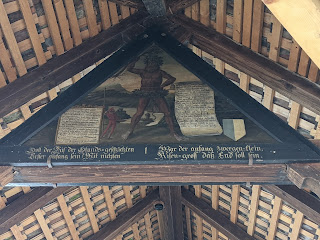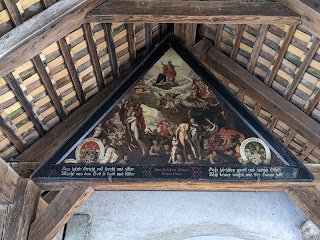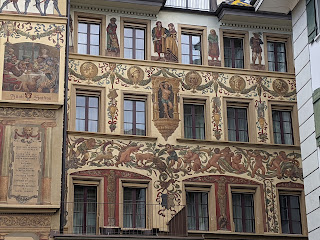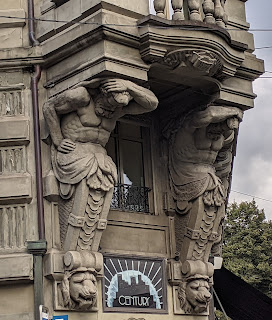
After being based in Interlaken for three nights to take advantage of its proximity for the top-notch hiking in the Berner Oberland, Steven and I hopped on an efficient Swiss Rail train for the two-hour ride to Luzern also known as Lucerne depending on whether you're using its German or French spelling. As the city is in the German-speaking area of Switzerland, I'll refer to it as Luzern (pronounced loot-SAIRN).
Views en route to Luzern from the train of Lake Brienz, one of the 'between lakes' to Interlaken.
The lake's sea green color reminded me of Lake Louise in Alberta.
It was hard to tell from the train but it appeared the Brunig-Hasliberg station was hosting a second-hand fair. Too bad we didn't have time to interrupt our journey to check out the treasures!
We may well have had time, after all, to check out the station as it took a while for the train to switch tracks to climb up the mountain pass ahead.
Living in these small mountain communities cannot be easy in the winter months.
Lungern, another attractive Swiss town:
Credit the Swiss for their large and immaculate on-train bathrooms - they were nothing like those we've experienced in other countries where noses must be pinched shut while inside!
The big stone arch outside the Luzern train station used to adorn the entrance to the 19th-century train station. The city became a top tourist destination in central Switzerland thanks to the advent of steam-powered trains and a favorite stop for visitors during the Romantic area, hosting celebrities such as Mark Twain, Goethe, and Queen Victoria.
Next to the station was the mammoth Culture and Convention Center with its overhanging roof designed in 1998 by French architect Jean Nouvel. Until he was voted down by city residents, he wanted to place the building directly in the middle of Lake Luzern! Instead, he surrounded the center with water anyway with open channels that went right through the middle of the building.
If we'd had more time in Luzern, it would have been lovely to take a lazy lake cruise but we only had a few hours before moving on to southern Switzerland in the morning.
On the other side of the station was the immense post office.
We walked just a few blocks alongside the Reuss River to reach Luzern's wooden landmark, Chapel Bridge with its octagonal stone Water Tower in the middle. After beginning as a fishing village, traffic between northern and southern Europe passed through the nearby Gotthard Pass by the 13th century. The bridge was constructed in the first half of the 14th century as part of the town ramparts to connect its medieval fortifications.
Chapel Bridge was decorated with paintings in the 17th century that depicted the town's development. Sadly, when a pleasure boat moored under the bridge caught fire in August of 1993, the famous landmark went up in flames and 81 of the 111 bridge paintings were burned. Photographic facsimiles were displayed to fill the enormous gap from 1994 to 2001.
The coats-of-arms on each painting told which rich family sponsored them. The first painting showed an icon of Luzern, a loveable giant who dated back to the Middle Ages when mammoth bones found locally were initially thought to be the bones of a 15-foot-tall human giant.
An angel in the second painting shone a divine light on the location where the town of Luzern would be born and where a monastery was founded in the 8th century. The city name, Luzern, roughly translates to "city of light."
We noticed the bridge was already part of the city fortifications around 1400 in the next painting.
Don't forget to just click on any photo if you want to see a bigger version!
It was clear that the city looked a lot bigger by 1630.
Kathy: I hope these photos bring back marvelous memories of the trip you made to Luzern with Jim.
A sign by the ninth and tenth paintings told that the bridge had begun to burn here before midnight on August 17th, 1993. That was why those paintings were charred black.
The wood in the middle of the bridge was a lighter color because it had been replaced after the fire. Most of those paintings were destroyed.
I'm sure local residents must have thanked their lucky stars that other paintings happened to be in storage at the time of the fire and therefore saved from any damage.
I wasn't trying to take a 'trick' shot with this next one that shows how the windows on the right or lake side were smaller than those on the inland side. They were intentionally built like that in order to give defenders more protection from lakeside attacks.
A view of the lake's inland side:
I had been fortunate to walk across Chapel Bridge and see its original paintings way back in 1975 on a visit while living in Geneva.
As a result of the fire, smoking is no longer allowed on the bridge and boats can no longer travel under the bridge. Tiny security cameras were everywhere on the bridge to enforce the no smoking policy.
After walking to the end, we retraced our steps on the bridge to the train station end to continue walking down the river
We stopped to admire the Jesuitenkirche or Jesuit Church, Switzerland's first major Baroque church. Built circa 1670, it was dedicated to Francis Xavier, a missionary and co-founder of the Jesuit Order.
Part of the facade showed Xavier baptizing Asians even though they were depicted looking like Indigenous Americans.
In the late 17th century, the pope wanted to establish a commanding presence in the central part of Switzerland even though Luzern was then quite small to shore up the Catholics following the Protestant Reformation.
Halfway up on the righthand side was the pulpit.
The ceiling decorations celebrated the life and afterlife of St. Francis Xavier.
In the central painting, we watch Xavier after he has died riding his chariot into heaven, being pulled by an elephant, leopard, and camel which commemorated his missionary trips to far parts of the world.
The artist included the papal representative, townsfolk, this church, and even Chapel Bridge in the painting.
One of the chapels honored Brother Klaus, the country's only saint, a 15th-century hermit who lived in the nearby mountains and brokered peace among warring Swiss cantons. Klaus is regarded as the country's first isolationist, a policy that Switzerland adheres to today by remaining neutral in international conflicts. On the statue was Klaus' original robe.
Having just visited the Chiesa del Gesu or Jesuit Church here in Rome where I am writing this post, I have enjoyed looking again at Luzern's Jesuit Church.
From another of Luzern's pedestrian bridges, we had a lovely view of Chapel Bridge.
When we had visited Interlaken earlier in the day, we had read about the devastation caused by the flooding from its Aare River. Lake Luzern's main source of water is snowmelt from the surrounding mountains and the city is responsible for controlling the amount of water draining from the lake into the Reuss on the way to the Rhine River so it doesn't flood villages on Lake Luzern. To do that, the city came up with a spiked weir system in the 19th-century which involves removing the wooden spikes when the water is highest in the spring and extending the pickets to keep the floor steady in the summer as the water level drops. The dam is closed entirely in the winter to keep the lake level high enough for boats.
I hope the workers get hazard pay as they must be tethered by an overhead safety cable to pull up the chain which hoists a metal platform on the river bottom.
Luzern History Museum:
Just up ahead was the second of Luzern's covered bridges, Mill Bridge. Fortunately, this was still the original one and also had a collection of rustic paintings.
Back again was Luzern's friendly giant but this time under the blue and white city and cantonal banners of the Holy Roman Empire's double eagle. The latter was a reminder that the emperor granted free access to Luzern.
The reverse depicted Judgement Day in which some went to heaven and some to hell
As we walked across the bridge, it was more than a little spooky noticing that each painting had a Grim Reaper theme going. With these paintings done in times of war and plague, they were a daily visual reminder to the passing townsfolk that nobody could escape death.
Halfway across the bridge was a small chapel that was constructed to seek divine assistance against destruction by flood. Family crests adorning the door acknowledged those volunteers who decorate the chapel seasonally.
Just like Chapel Bridge, Mill Bridge was part of the city fortifications so its downstream windows were higher.
Looking toward Chapel Bridge in the distance with the weir system and other bridge in the foreground:
The far end of the bridge was created to allow wagons delivering grain to be milled in one of the three mills in an area that was the heart of industrial Luzern. I could understand why this bridge, therefore, derived its name as Mill Bridge but why was the first one called Chapel Bridge as it had no chapel?!
The turbine at the end of the bridge generated power until 1889 but now a modern hydroelectric plant underwater creates harnessed enough water to power 1,000 homes.
Just beyond the bridge was Muhlenplatz, a car-free square that marked the entrance to Luzern's Old Town.
A mural on a building in the center of the square showed the city when the mills were prevalent. You can see them more clearly if you click on the photo to enlarge it.
The statue was described as the Swiss Marilyn Monroe by travel writer Rick Steves!
Though we were heading toward another square, I was compelled to stop when we saw the paintings on this building. One of my favorite memories of our time in Switzerland is of the many buildings in Zurich and especially tiny Appenzell that had exquisite murals or paintings on them
Walking on, we reached Weinmarkt which used to serve in Luzern's Middle Ages as a market for wine as the name implied!
The soldiers on the fountain were there to remind all of us that Luzern was strong and tough!
You wouldn't be the only one to look at this building's paintings and think they depicted The Last Supper. In fact, in keeping with the square's theme, it was the Wedding Feast at Cana where Jesus transformed water into wine.
Initially, the zigzags on the shutters looked just like that - zigzags. However, when you click on the photo you'll be able to see more closely the funny lines spelled out from the top left W-E-I-N-M-A-R-K-T. I loved it!
Hirschenplatz, the next square was named after the Hirschen (Deer) Hotel but its only memory was the ornamental golden sign.
The largest building on the square looked so much like the many others we'd already seen with its elaborate muralled facade. That was until we spied all the golden rings and, at the top, Cupid shooting his arrow, clear signs that a jeweler used to have his business here.
The resplendent facade of the Dornach House acknowledged the 400-year-old anniversary of the last skirmish against the Habsburgs. The Swiss recognize that while there can be disagreements with its often militaristic and aggressive neighbors, wars are not an option.
On the corner, a painting announced that Johann Goethe, considered to be Germany's top literary figure of the modern area, stayed at a hotel here when he visited Luzern.
One had to commend Luzern's leaders for requiring every building in the Old Town to offer residential apartments so it wouldn't just be a haven for office space and touristy shops as we had sadly observed in other cities.
I couldn't help but smile when I happened to glimpse down an alley and notice the mural featuring Max, the central character from Where the Wild Things Are as our 16-month-old granddaughter was also called Max! I hope someday she can have a picture taken of herself here.
Nearby was yet another square, Sternenplatz. This tiny square was dominated by Restaurant Fritschi's eye-catching facade which portrayed characters and symbols from Luzern's biggest annual event, the Mardi Gras celebration, called Fasnacht here.
At the top of the building were Mr. and Mrs. Fritschi, the festival's boosters, celebrating Fasnacht by wearing masks and tossing oranges.
Beside them were their servants, dressed as a jester and nanny.
The story of Fasnacht was told with the cock crowing at 5 the Thursday preceding Ash Wednesday ...
one of the townspeople getting up to frighten winter away ...
and the Fritschis arriving on their wagon to inaugurate the festivities while throwing oranges around to their fervent fans! Oranges were once rare in Luzern winters and are fan favorites at Fasnacht as they are the harbingers of spring. I wonder when the exciting painting/mural was painted.
Lest you think the Swiss are not the most exciting people, the fountain in the next square was also all about Fasnacht. This is where about 10,000 locals gather at 5am to kick off the year's biggest party.
Sign of the times: a Covid-19 testing center in downtown Luzern.
On our way to our next stop, I wanted to stop and give this bear a hug!
The Lion Monument was a colossal sculpture that measured 33 feet long and 20 feet tall carved directly into a cliff face over a reflecting pool in a serene park. The monument with Latin inscriptions was unveiled in 1821 after being designed in Rome by one of the most famous sculptors of the day, Danish artist Bertel Thorvaldsen.
It was an anti-revolutionary ode to commemorate dramatic events in Paris when an angry mob stormed the Tuileries Palace in Paris and killed hundreds of Swiss Guardsmen serving King Louis VVI. The Latin message carved into the rock above the lion praised the loyalty and bravery of the Swiss Guard who had been recruited as mercenary soldiers to serve for French kings for three hundred years from the 15th to the 18th centuries.
Just look at the once-mighty lion resting his paws on a shield with tears streaming down his face, a broken-off tip of a spear slowly killing him.
Although the political message was controversial, the sculptor's artistry has always drawn praise. I understand it's considered one of the most famous statues in the world and also one of the most popular tourist attractions in Switzerland.
The trek to the monument in the park had been well worth it but the experience using its public bathroom was the icing on the cake!
Steven and I both laughed after we remarked on having read this sign that advised lowering the seat before sitting down! That made sense as, otherwise, one would have an inadvertent half bath. I'd never encountered a toilet seat that went up automatically when the toilet was flushed.
An evening cruise on Lake Luzern looked like it would be very enjoyable.
Although we only had a few short hours in Luzern, we'd been charmed by its wooden bridges, colorful wall paintings on so many buildings, and the loveable friendly giant. As you can imagine, having schlepped over 26,000 steps and 11 plus miles from our walks in both Interlaken and Luzern, our feet were tired after returning to the hostel for our one-night stay.
Next post: Onto the Italian-speaking city of Lugano in southern Switzerland's Ticino region.
Posted on November 8th, 2021, from Rome where we're off shortly to tour some of the city's most iconic sights - the Colosseum, Roman Forum, and St. Peter's Basilica.

















































































































































Oh. My. God. My Mongolian buddies. And you're still at it. Two lovebirds flitting about the world. Plus you don't look like you've aged a day since I last saw ye's. Happiness is the best facelift? When are you coming to Ireland? Mind you, I'm about to edit a new book & then head for Spain, Dec 20 to Jan 6. Email me at info@ormelling.com. What are your plans? Could we zoom? Can't believe you're roaming around during a pandemic lol. That would be ye. Big hugs & lots of love, Val
ReplyDeleteMy God, Val, what a breath of fresh air hearing from you after way, way too long! I don't think I've ever laughed as much as I did in those few days we spent together in far flung Mongolia back in 2013. It'll be so much fun reconnecting in Dublin on the 20th - I can hardly wait to catch up with you.
ReplyDeleteAnnie